Food Security in Sierra Leone: A Comprehensive Case Study Analysis
VerifiedAdded on 2022/10/08
|17
|3831
|16
Case Study
AI Summary
This case study examines the food system in Sierra Leone, a country facing significant food security challenges. The analysis covers various aspects of the food system, including food utilization, access, and availability, while also assessing the supporting resources, policies, and organizations. It identifies and analyzes risks associated with the food system, such as climate change, demographic shifts, socioeconomic factors, and political instability. The study proposes recommendations to protect and strengthen the food system, focusing on enhancing resilience. Furthermore, it evaluates the effectiveness of existing government policies, like the National Food and Nutrition Policy and the National Sustainable Agriculture Development Plan, in supporting food security initiatives. The report concludes with an optimistic outlook for improved food security in Sierra Leone, which will lead to better health and well-being of the population.
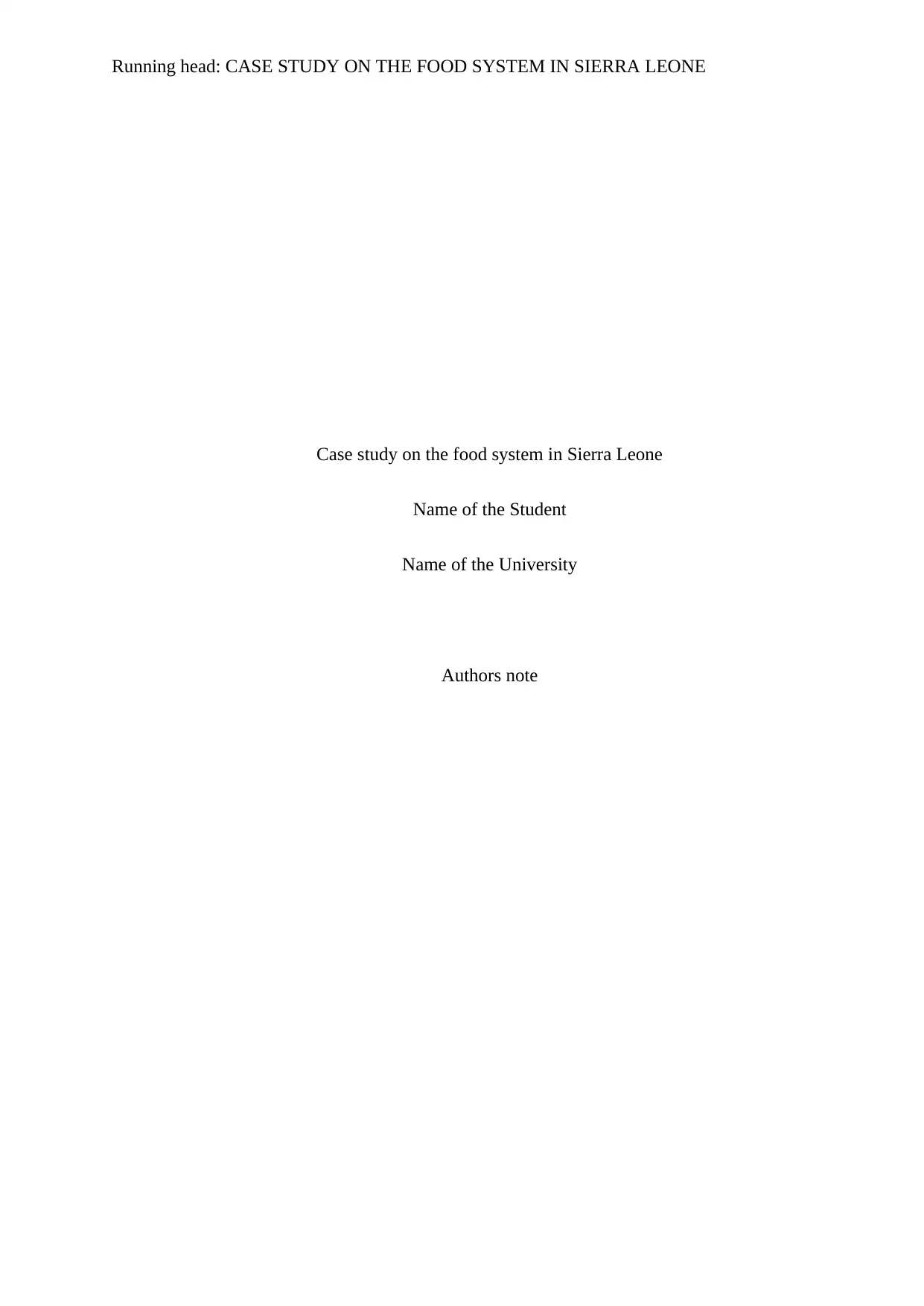
Running head: CASE STUDY ON THE FOOD SYSTEM IN SIERRA LEONE
Case study on the food system in Sierra Leone
Name of the Student
Name of the University
Authors note
Case study on the food system in Sierra Leone
Name of the Student
Name of the University
Authors note
Paraphrase This Document
Need a fresh take? Get an instant paraphrase of this document with our AI Paraphraser
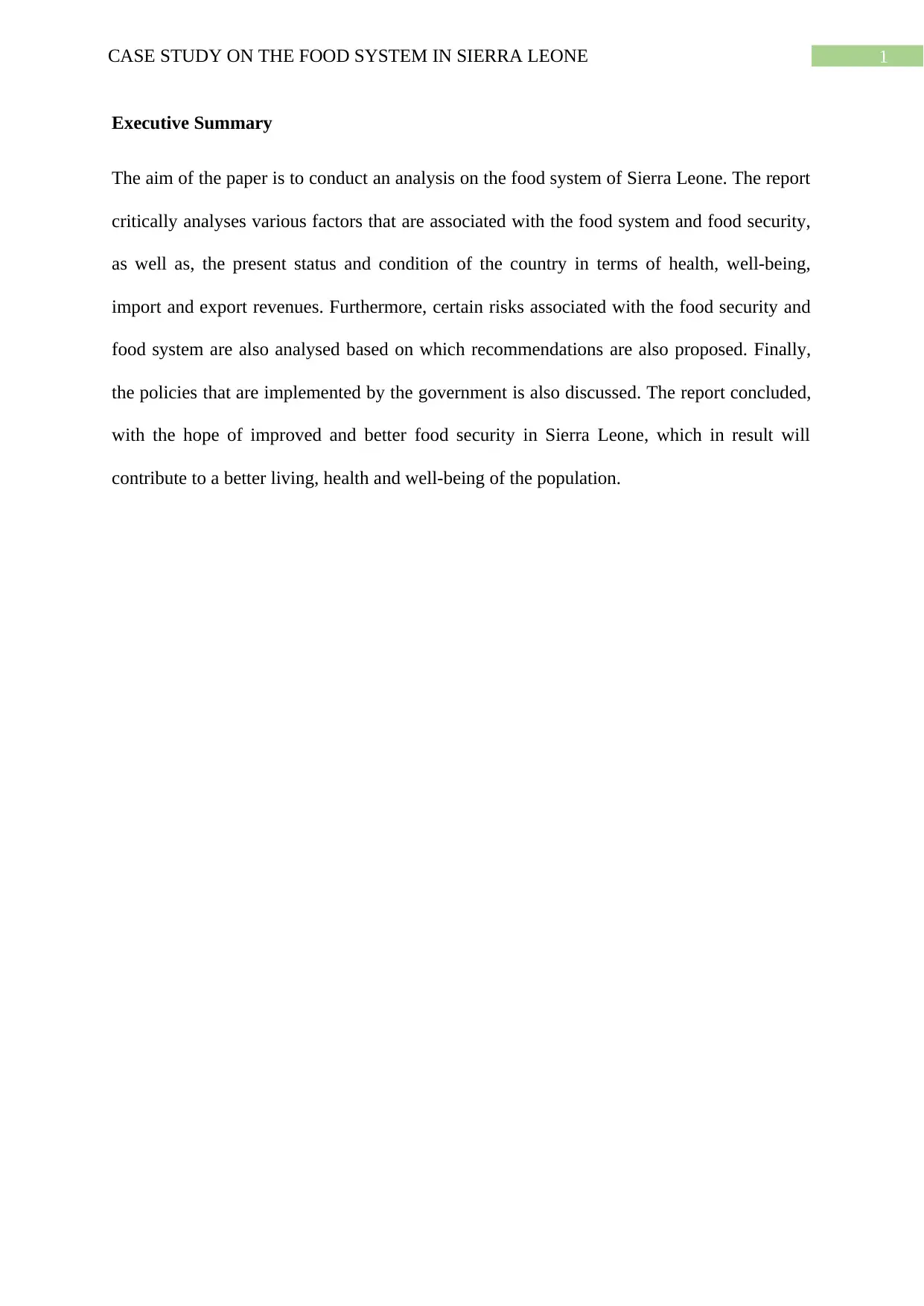
1CASE STUDY ON THE FOOD SYSTEM IN SIERRA LEONE
Executive Summary
The aim of the paper is to conduct an analysis on the food system of Sierra Leone. The report
critically analyses various factors that are associated with the food system and food security,
as well as, the present status and condition of the country in terms of health, well-being,
import and export revenues. Furthermore, certain risks associated with the food security and
food system are also analysed based on which recommendations are also proposed. Finally,
the policies that are implemented by the government is also discussed. The report concluded,
with the hope of improved and better food security in Sierra Leone, which in result will
contribute to a better living, health and well-being of the population.
Executive Summary
The aim of the paper is to conduct an analysis on the food system of Sierra Leone. The report
critically analyses various factors that are associated with the food system and food security,
as well as, the present status and condition of the country in terms of health, well-being,
import and export revenues. Furthermore, certain risks associated with the food security and
food system are also analysed based on which recommendations are also proposed. Finally,
the policies that are implemented by the government is also discussed. The report concluded,
with the hope of improved and better food security in Sierra Leone, which in result will
contribute to a better living, health and well-being of the population.
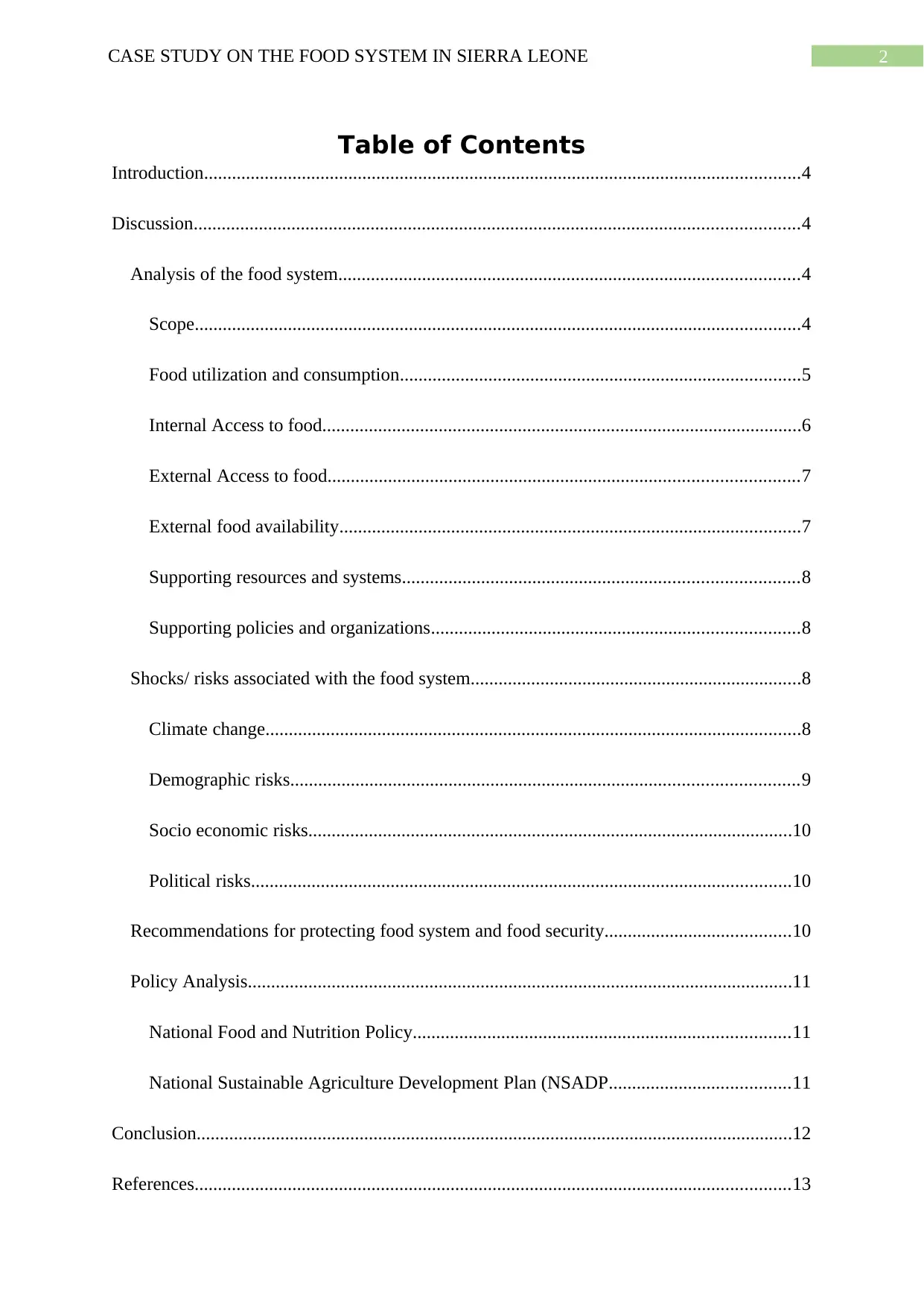
2CASE STUDY ON THE FOOD SYSTEM IN SIERRA LEONE
Table of Contents
Introduction................................................................................................................................4
Discussion..................................................................................................................................4
Analysis of the food system...................................................................................................4
Scope..................................................................................................................................4
Food utilization and consumption......................................................................................5
Internal Access to food.......................................................................................................6
External Access to food.....................................................................................................7
External food availability...................................................................................................7
Supporting resources and systems.....................................................................................8
Supporting policies and organizations...............................................................................8
Shocks/ risks associated with the food system.......................................................................8
Climate change...................................................................................................................8
Demographic risks.............................................................................................................9
Socio economic risks........................................................................................................10
Political risks....................................................................................................................10
Recommendations for protecting food system and food security........................................10
Policy Analysis.....................................................................................................................11
National Food and Nutrition Policy.................................................................................11
National Sustainable Agriculture Development Plan (NSADP.......................................11
Conclusion................................................................................................................................12
References................................................................................................................................13
Table of Contents
Introduction................................................................................................................................4
Discussion..................................................................................................................................4
Analysis of the food system...................................................................................................4
Scope..................................................................................................................................4
Food utilization and consumption......................................................................................5
Internal Access to food.......................................................................................................6
External Access to food.....................................................................................................7
External food availability...................................................................................................7
Supporting resources and systems.....................................................................................8
Supporting policies and organizations...............................................................................8
Shocks/ risks associated with the food system.......................................................................8
Climate change...................................................................................................................8
Demographic risks.............................................................................................................9
Socio economic risks........................................................................................................10
Political risks....................................................................................................................10
Recommendations for protecting food system and food security........................................10
Policy Analysis.....................................................................................................................11
National Food and Nutrition Policy.................................................................................11
National Sustainable Agriculture Development Plan (NSADP.......................................11
Conclusion................................................................................................................................12
References................................................................................................................................13
⊘ This is a preview!⊘
Do you want full access?
Subscribe today to unlock all pages.

Trusted by 1+ million students worldwide
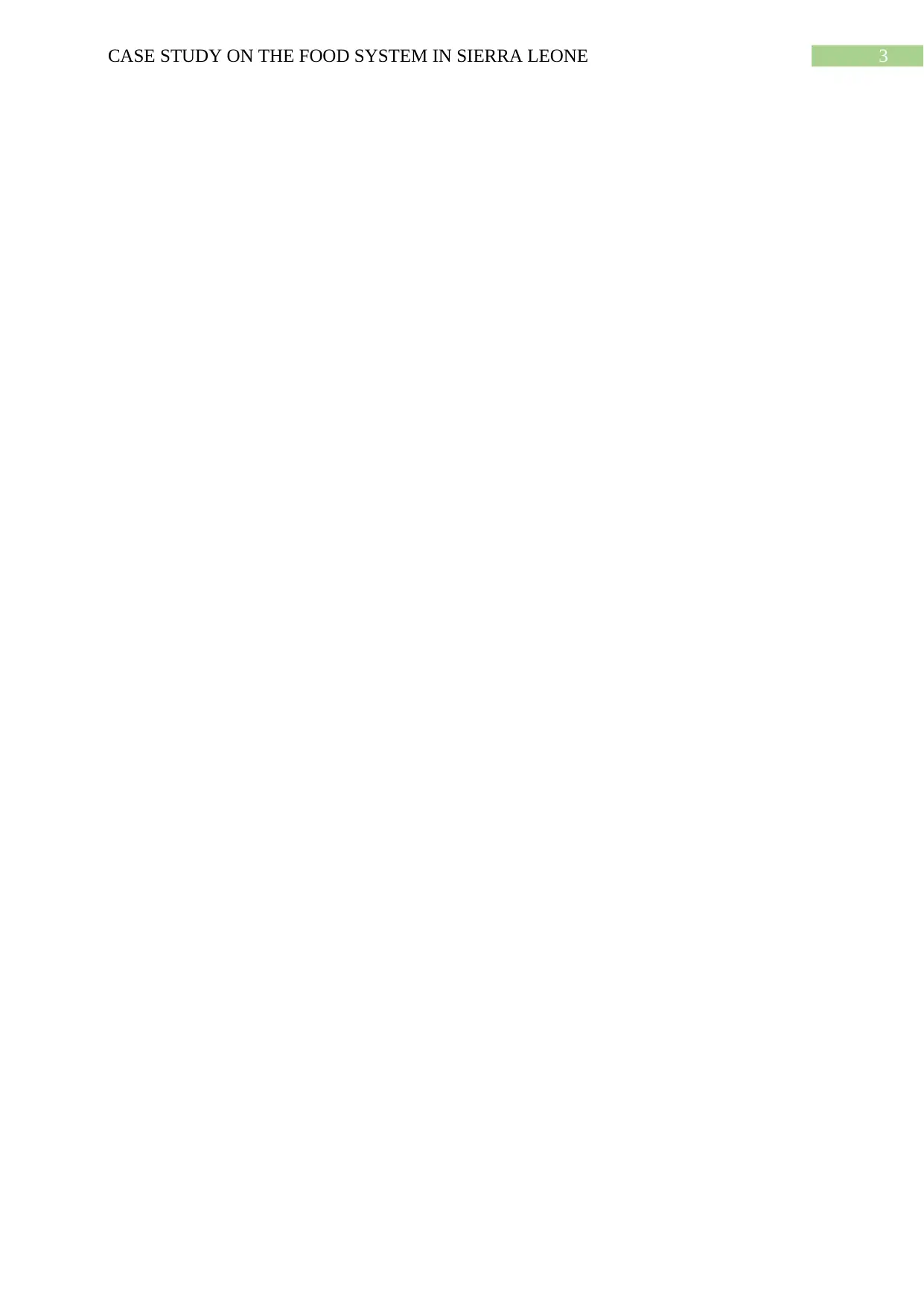
3CASE STUDY ON THE FOOD SYSTEM IN SIERRA LEONE
Paraphrase This Document
Need a fresh take? Get an instant paraphrase of this document with our AI Paraphraser
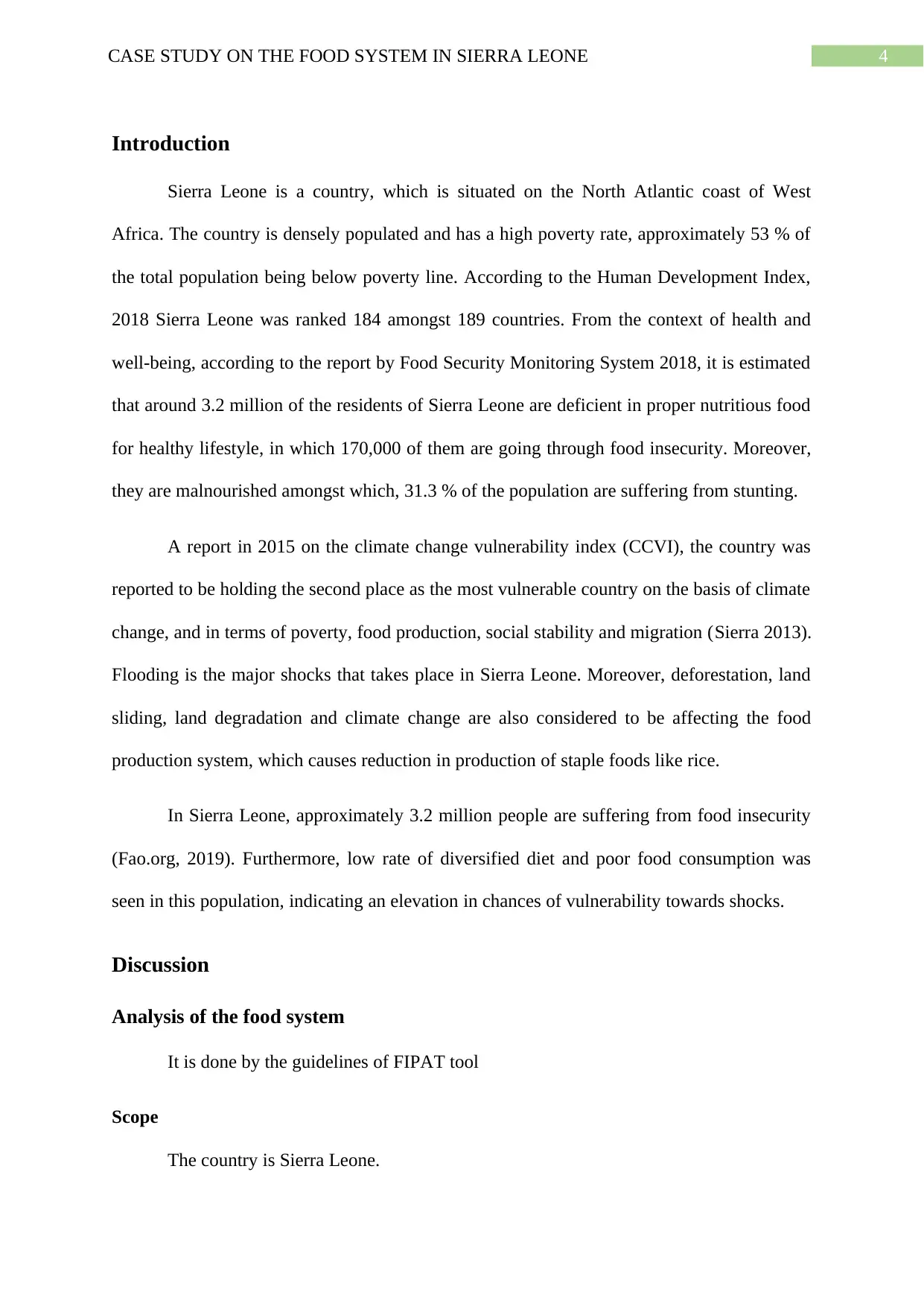
4CASE STUDY ON THE FOOD SYSTEM IN SIERRA LEONE
Introduction
Sierra Leone is a country, which is situated on the North Atlantic coast of West
Africa. The country is densely populated and has a high poverty rate, approximately 53 % of
the total population being below poverty line. According to the Human Development Index,
2018 Sierra Leone was ranked 184 amongst 189 countries. From the context of health and
well-being, according to the report by Food Security Monitoring System 2018, it is estimated
that around 3.2 million of the residents of Sierra Leone are deficient in proper nutritious food
for healthy lifestyle, in which 170,000 of them are going through food insecurity. Moreover,
they are malnourished amongst which, 31.3 % of the population are suffering from stunting.
A report in 2015 on the climate change vulnerability index (CCVI), the country was
reported to be holding the second place as the most vulnerable country on the basis of climate
change, and in terms of poverty, food production, social stability and migration (Sierra 2013).
Flooding is the major shocks that takes place in Sierra Leone. Moreover, deforestation, land
sliding, land degradation and climate change are also considered to be affecting the food
production system, which causes reduction in production of staple foods like rice.
In Sierra Leone, approximately 3.2 million people are suffering from food insecurity
(Fao.org, 2019). Furthermore, low rate of diversified diet and poor food consumption was
seen in this population, indicating an elevation in chances of vulnerability towards shocks.
Discussion
Analysis of the food system
It is done by the guidelines of FIPAT tool
Scope
The country is Sierra Leone.
Introduction
Sierra Leone is a country, which is situated on the North Atlantic coast of West
Africa. The country is densely populated and has a high poverty rate, approximately 53 % of
the total population being below poverty line. According to the Human Development Index,
2018 Sierra Leone was ranked 184 amongst 189 countries. From the context of health and
well-being, according to the report by Food Security Monitoring System 2018, it is estimated
that around 3.2 million of the residents of Sierra Leone are deficient in proper nutritious food
for healthy lifestyle, in which 170,000 of them are going through food insecurity. Moreover,
they are malnourished amongst which, 31.3 % of the population are suffering from stunting.
A report in 2015 on the climate change vulnerability index (CCVI), the country was
reported to be holding the second place as the most vulnerable country on the basis of climate
change, and in terms of poverty, food production, social stability and migration (Sierra 2013).
Flooding is the major shocks that takes place in Sierra Leone. Moreover, deforestation, land
sliding, land degradation and climate change are also considered to be affecting the food
production system, which causes reduction in production of staple foods like rice.
In Sierra Leone, approximately 3.2 million people are suffering from food insecurity
(Fao.org, 2019). Furthermore, low rate of diversified diet and poor food consumption was
seen in this population, indicating an elevation in chances of vulnerability towards shocks.
Discussion
Analysis of the food system
It is done by the guidelines of FIPAT tool
Scope
The country is Sierra Leone.
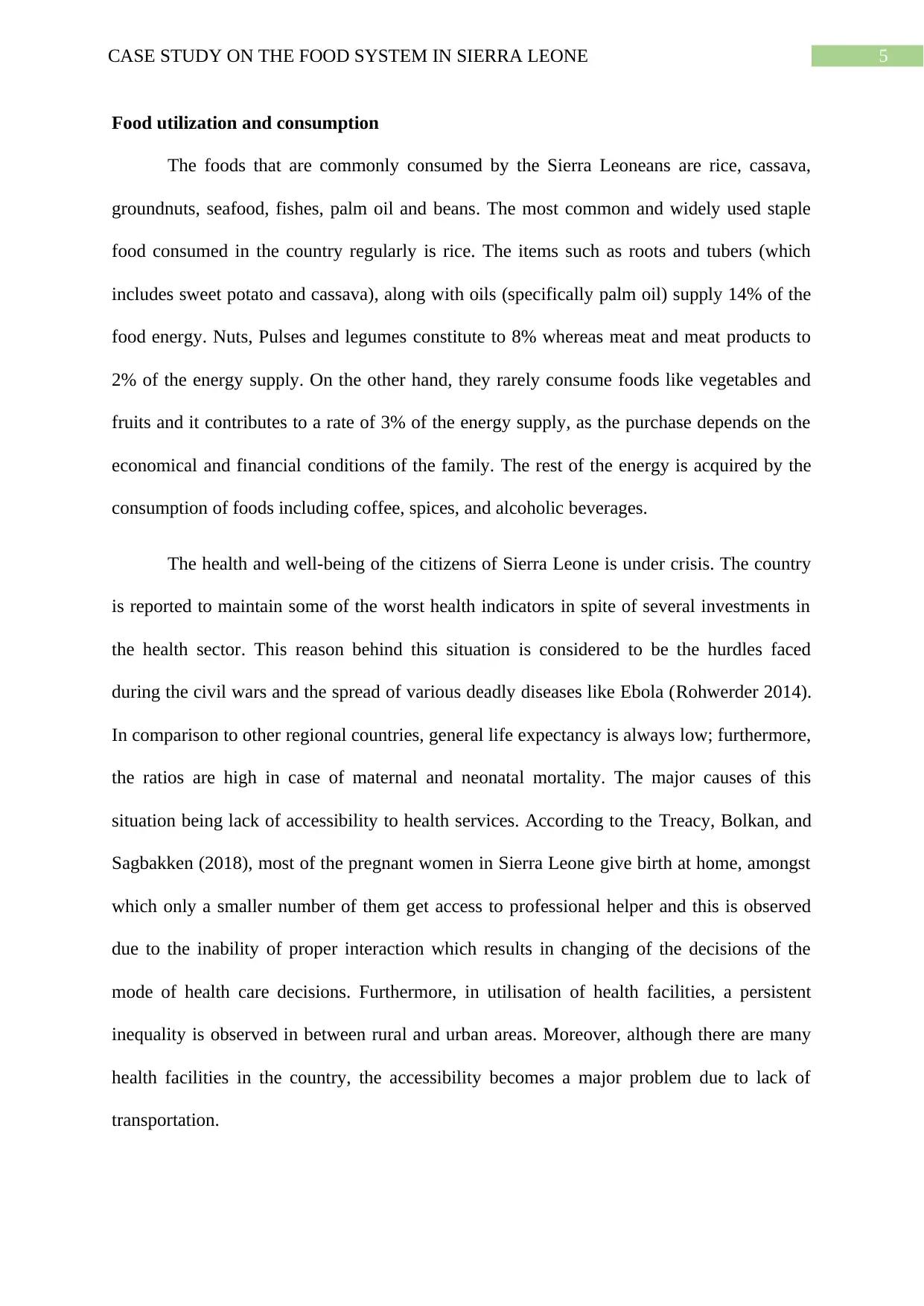
5CASE STUDY ON THE FOOD SYSTEM IN SIERRA LEONE
Food utilization and consumption
The foods that are commonly consumed by the Sierra Leoneans are rice, cassava,
groundnuts, seafood, fishes, palm oil and beans. The most common and widely used staple
food consumed in the country regularly is rice. The items such as roots and tubers (which
includes sweet potato and cassava), along with oils (specifically palm oil) supply 14% of the
food energy. Nuts, Pulses and legumes constitute to 8% whereas meat and meat products to
2% of the energy supply. On the other hand, they rarely consume foods like vegetables and
fruits and it contributes to a rate of 3% of the energy supply, as the purchase depends on the
economical and financial conditions of the family. The rest of the energy is acquired by the
consumption of foods including coffee, spices, and alcoholic beverages.
The health and well-being of the citizens of Sierra Leone is under crisis. The country
is reported to maintain some of the worst health indicators in spite of several investments in
the health sector. This reason behind this situation is considered to be the hurdles faced
during the civil wars and the spread of various deadly diseases like Ebola (Rohwerder 2014).
In comparison to other regional countries, general life expectancy is always low; furthermore,
the ratios are high in case of maternal and neonatal mortality. The major causes of this
situation being lack of accessibility to health services. According to the Treacy, Bolkan, and
Sagbakken (2018), most of the pregnant women in Sierra Leone give birth at home, amongst
which only a smaller number of them get access to professional helper and this is observed
due to the inability of proper interaction which results in changing of the decisions of the
mode of health care decisions. Furthermore, in utilisation of health facilities, a persistent
inequality is observed in between rural and urban areas. Moreover, although there are many
health facilities in the country, the accessibility becomes a major problem due to lack of
transportation.
Food utilization and consumption
The foods that are commonly consumed by the Sierra Leoneans are rice, cassava,
groundnuts, seafood, fishes, palm oil and beans. The most common and widely used staple
food consumed in the country regularly is rice. The items such as roots and tubers (which
includes sweet potato and cassava), along with oils (specifically palm oil) supply 14% of the
food energy. Nuts, Pulses and legumes constitute to 8% whereas meat and meat products to
2% of the energy supply. On the other hand, they rarely consume foods like vegetables and
fruits and it contributes to a rate of 3% of the energy supply, as the purchase depends on the
economical and financial conditions of the family. The rest of the energy is acquired by the
consumption of foods including coffee, spices, and alcoholic beverages.
The health and well-being of the citizens of Sierra Leone is under crisis. The country
is reported to maintain some of the worst health indicators in spite of several investments in
the health sector. This reason behind this situation is considered to be the hurdles faced
during the civil wars and the spread of various deadly diseases like Ebola (Rohwerder 2014).
In comparison to other regional countries, general life expectancy is always low; furthermore,
the ratios are high in case of maternal and neonatal mortality. The major causes of this
situation being lack of accessibility to health services. According to the Treacy, Bolkan, and
Sagbakken (2018), most of the pregnant women in Sierra Leone give birth at home, amongst
which only a smaller number of them get access to professional helper and this is observed
due to the inability of proper interaction which results in changing of the decisions of the
mode of health care decisions. Furthermore, in utilisation of health facilities, a persistent
inequality is observed in between rural and urban areas. Moreover, although there are many
health facilities in the country, the accessibility becomes a major problem due to lack of
transportation.
⊘ This is a preview!⊘
Do you want full access?
Subscribe today to unlock all pages.

Trusted by 1+ million students worldwide
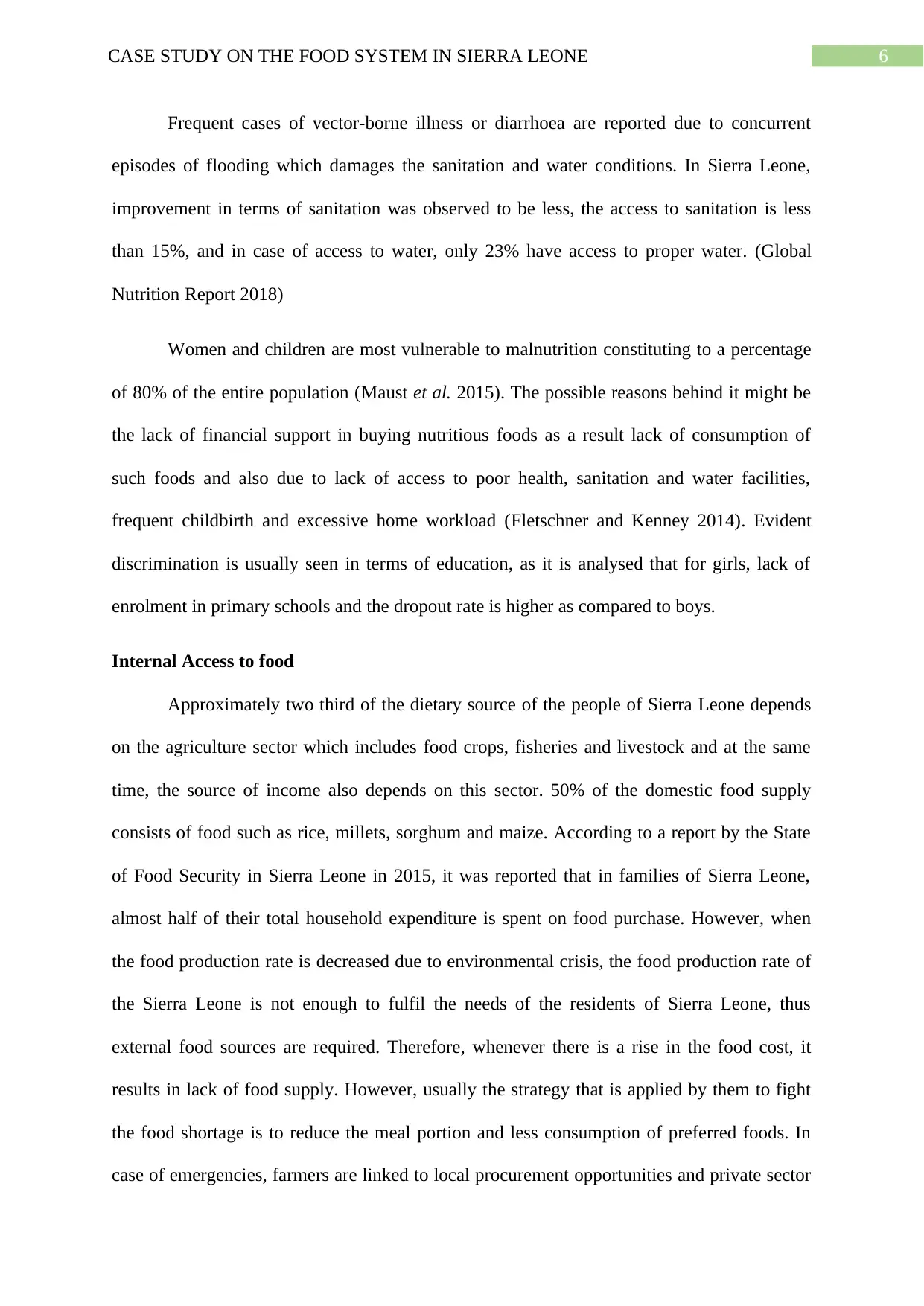
6CASE STUDY ON THE FOOD SYSTEM IN SIERRA LEONE
Frequent cases of vector-borne illness or diarrhoea are reported due to concurrent
episodes of flooding which damages the sanitation and water conditions. In Sierra Leone,
improvement in terms of sanitation was observed to be less, the access to sanitation is less
than 15%, and in case of access to water, only 23% have access to proper water. (Global
Nutrition Report 2018)
Women and children are most vulnerable to malnutrition constituting to a percentage
of 80% of the entire population (Maust et al. 2015). The possible reasons behind it might be
the lack of financial support in buying nutritious foods as a result lack of consumption of
such foods and also due to lack of access to poor health, sanitation and water facilities,
frequent childbirth and excessive home workload (Fletschner and Kenney 2014). Evident
discrimination is usually seen in terms of education, as it is analysed that for girls, lack of
enrolment in primary schools and the dropout rate is higher as compared to boys.
Internal Access to food
Approximately two third of the dietary source of the people of Sierra Leone depends
on the agriculture sector which includes food crops, fisheries and livestock and at the same
time, the source of income also depends on this sector. 50% of the domestic food supply
consists of food such as rice, millets, sorghum and maize. According to a report by the State
of Food Security in Sierra Leone in 2015, it was reported that in families of Sierra Leone,
almost half of their total household expenditure is spent on food purchase. However, when
the food production rate is decreased due to environmental crisis, the food production rate of
the Sierra Leone is not enough to fulfil the needs of the residents of Sierra Leone, thus
external food sources are required. Therefore, whenever there is a rise in the food cost, it
results in lack of food supply. However, usually the strategy that is applied by them to fight
the food shortage is to reduce the meal portion and less consumption of preferred foods. In
case of emergencies, farmers are linked to local procurement opportunities and private sector
Frequent cases of vector-borne illness or diarrhoea are reported due to concurrent
episodes of flooding which damages the sanitation and water conditions. In Sierra Leone,
improvement in terms of sanitation was observed to be less, the access to sanitation is less
than 15%, and in case of access to water, only 23% have access to proper water. (Global
Nutrition Report 2018)
Women and children are most vulnerable to malnutrition constituting to a percentage
of 80% of the entire population (Maust et al. 2015). The possible reasons behind it might be
the lack of financial support in buying nutritious foods as a result lack of consumption of
such foods and also due to lack of access to poor health, sanitation and water facilities,
frequent childbirth and excessive home workload (Fletschner and Kenney 2014). Evident
discrimination is usually seen in terms of education, as it is analysed that for girls, lack of
enrolment in primary schools and the dropout rate is higher as compared to boys.
Internal Access to food
Approximately two third of the dietary source of the people of Sierra Leone depends
on the agriculture sector which includes food crops, fisheries and livestock and at the same
time, the source of income also depends on this sector. 50% of the domestic food supply
consists of food such as rice, millets, sorghum and maize. According to a report by the State
of Food Security in Sierra Leone in 2015, it was reported that in families of Sierra Leone,
almost half of their total household expenditure is spent on food purchase. However, when
the food production rate is decreased due to environmental crisis, the food production rate of
the Sierra Leone is not enough to fulfil the needs of the residents of Sierra Leone, thus
external food sources are required. Therefore, whenever there is a rise in the food cost, it
results in lack of food supply. However, usually the strategy that is applied by them to fight
the food shortage is to reduce the meal portion and less consumption of preferred foods. In
case of emergencies, farmers are linked to local procurement opportunities and private sector
Paraphrase This Document
Need a fresh take? Get an instant paraphrase of this document with our AI Paraphraser
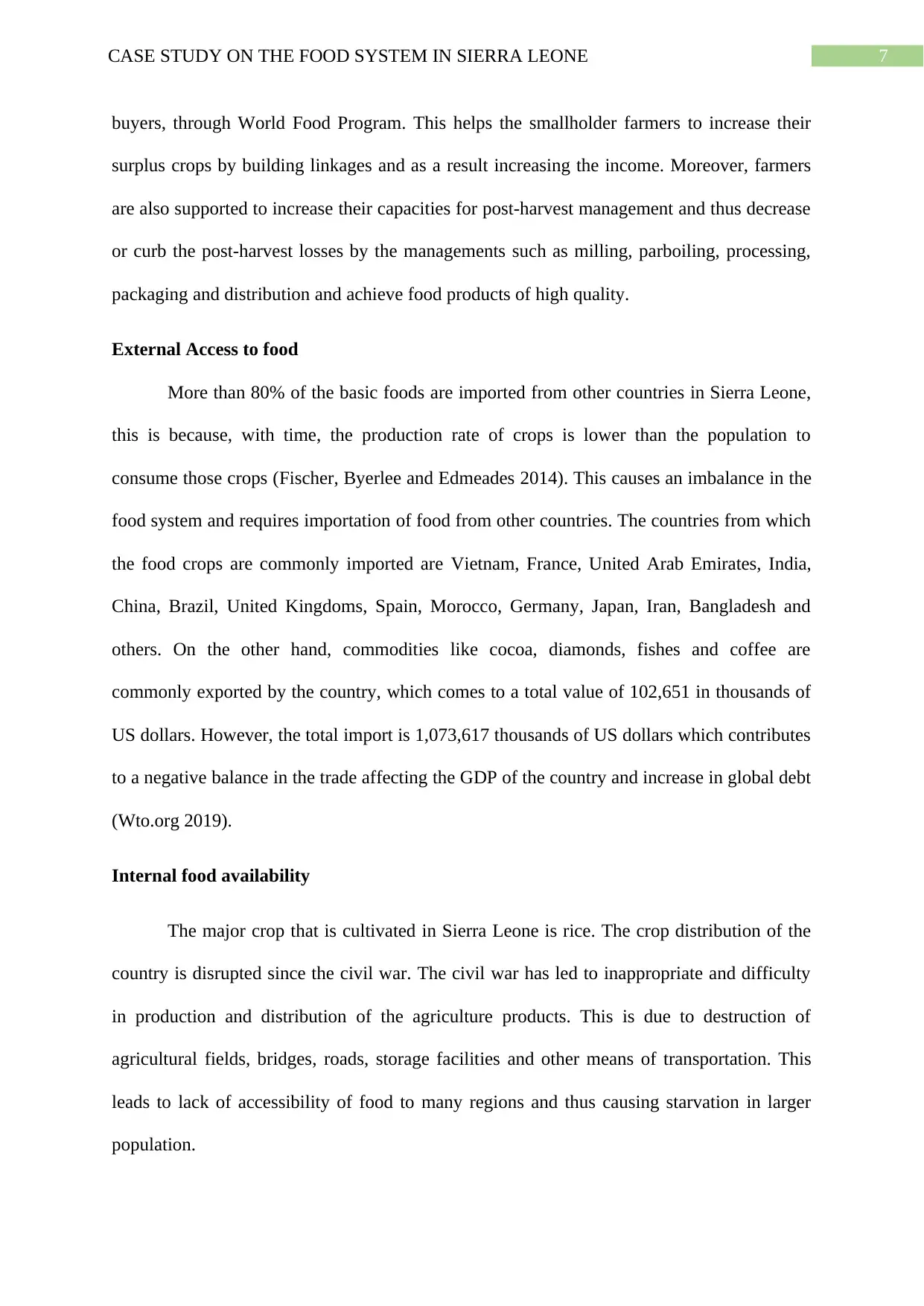
7CASE STUDY ON THE FOOD SYSTEM IN SIERRA LEONE
buyers, through World Food Program. This helps the smallholder farmers to increase their
surplus crops by building linkages and as a result increasing the income. Moreover, farmers
are also supported to increase their capacities for post-harvest management and thus decrease
or curb the post-harvest losses by the managements such as milling, parboiling, processing,
packaging and distribution and achieve food products of high quality.
External Access to food
More than 80% of the basic foods are imported from other countries in Sierra Leone,
this is because, with time, the production rate of crops is lower than the population to
consume those crops (Fischer, Byerlee and Edmeades 2014). This causes an imbalance in the
food system and requires importation of food from other countries. The countries from which
the food crops are commonly imported are Vietnam, France, United Arab Emirates, India,
China, Brazil, United Kingdoms, Spain, Morocco, Germany, Japan, Iran, Bangladesh and
others. On the other hand, commodities like cocoa, diamonds, fishes and coffee are
commonly exported by the country, which comes to a total value of 102,651 in thousands of
US dollars. However, the total import is 1,073,617 thousands of US dollars which contributes
to a negative balance in the trade affecting the GDP of the country and increase in global debt
(Wto.org 2019).
Internal food availability
The major crop that is cultivated in Sierra Leone is rice. The crop distribution of the
country is disrupted since the civil war. The civil war has led to inappropriate and difficulty
in production and distribution of the agriculture products. This is due to destruction of
agricultural fields, bridges, roads, storage facilities and other means of transportation. This
leads to lack of accessibility of food to many regions and thus causing starvation in larger
population.
buyers, through World Food Program. This helps the smallholder farmers to increase their
surplus crops by building linkages and as a result increasing the income. Moreover, farmers
are also supported to increase their capacities for post-harvest management and thus decrease
or curb the post-harvest losses by the managements such as milling, parboiling, processing,
packaging and distribution and achieve food products of high quality.
External Access to food
More than 80% of the basic foods are imported from other countries in Sierra Leone,
this is because, with time, the production rate of crops is lower than the population to
consume those crops (Fischer, Byerlee and Edmeades 2014). This causes an imbalance in the
food system and requires importation of food from other countries. The countries from which
the food crops are commonly imported are Vietnam, France, United Arab Emirates, India,
China, Brazil, United Kingdoms, Spain, Morocco, Germany, Japan, Iran, Bangladesh and
others. On the other hand, commodities like cocoa, diamonds, fishes and coffee are
commonly exported by the country, which comes to a total value of 102,651 in thousands of
US dollars. However, the total import is 1,073,617 thousands of US dollars which contributes
to a negative balance in the trade affecting the GDP of the country and increase in global debt
(Wto.org 2019).
Internal food availability
The major crop that is cultivated in Sierra Leone is rice. The crop distribution of the
country is disrupted since the civil war. The civil war has led to inappropriate and difficulty
in production and distribution of the agriculture products. This is due to destruction of
agricultural fields, bridges, roads, storage facilities and other means of transportation. This
leads to lack of accessibility of food to many regions and thus causing starvation in larger
population.
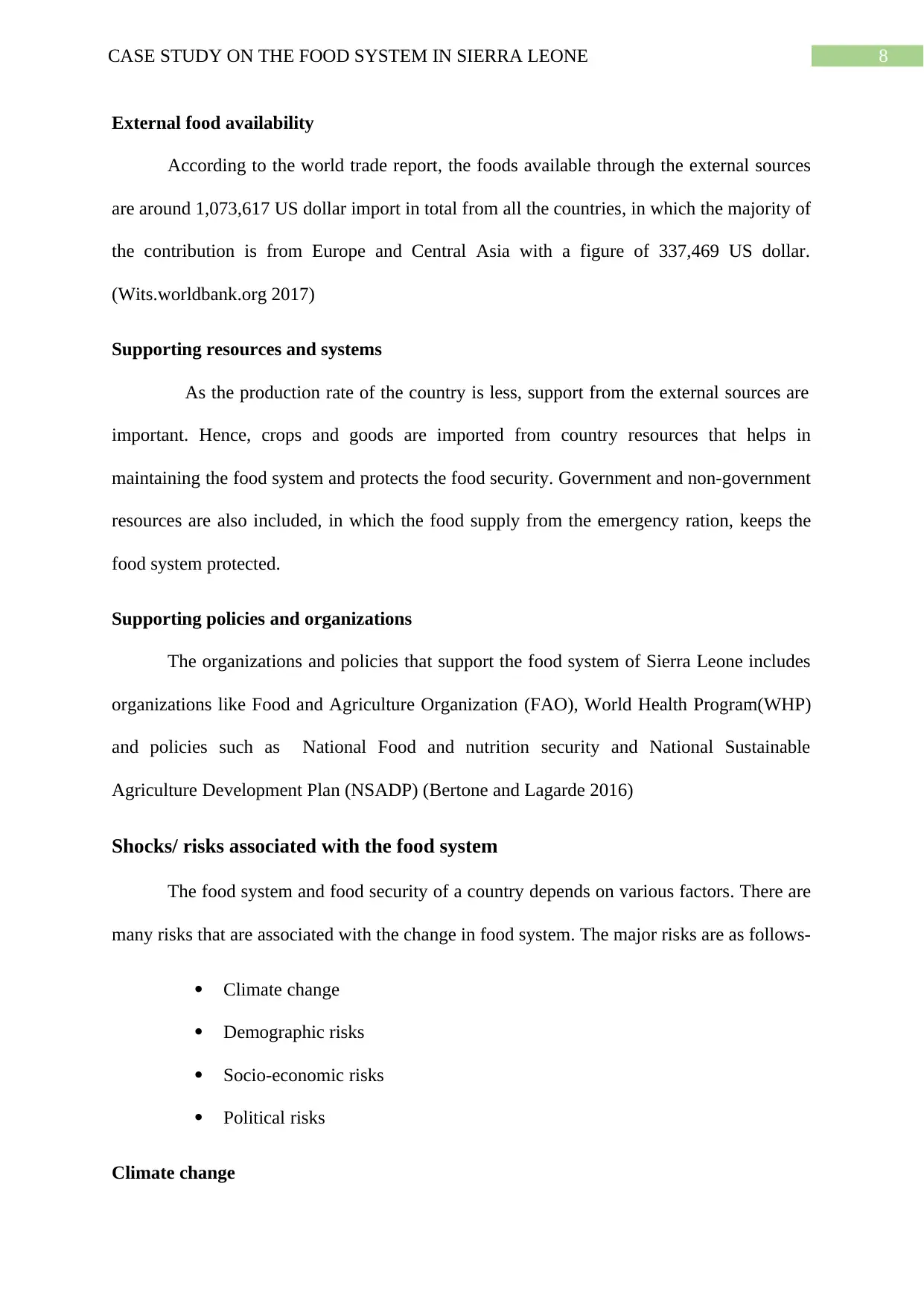
8CASE STUDY ON THE FOOD SYSTEM IN SIERRA LEONE
External food availability
According to the world trade report, the foods available through the external sources
are around 1,073,617 US dollar import in total from all the countries, in which the majority of
the contribution is from Europe and Central Asia with a figure of 337,469 US dollar.
(Wits.worldbank.org 2017)
Supporting resources and systems
As the production rate of the country is less, support from the external sources are
important. Hence, crops and goods are imported from country resources that helps in
maintaining the food system and protects the food security. Government and non-government
resources are also included, in which the food supply from the emergency ration, keeps the
food system protected.
Supporting policies and organizations
The organizations and policies that support the food system of Sierra Leone includes
organizations like Food and Agriculture Organization (FAO), World Health Program(WHP)
and policies such as National Food and nutrition security and National Sustainable
Agriculture Development Plan (NSADP) (Bertone and Lagarde 2016)
Shocks/ risks associated with the food system
The food system and food security of a country depends on various factors. There are
many risks that are associated with the change in food system. The major risks are as follows-
Climate change
Demographic risks
Socio-economic risks
Political risks
Climate change
External food availability
According to the world trade report, the foods available through the external sources
are around 1,073,617 US dollar import in total from all the countries, in which the majority of
the contribution is from Europe and Central Asia with a figure of 337,469 US dollar.
(Wits.worldbank.org 2017)
Supporting resources and systems
As the production rate of the country is less, support from the external sources are
important. Hence, crops and goods are imported from country resources that helps in
maintaining the food system and protects the food security. Government and non-government
resources are also included, in which the food supply from the emergency ration, keeps the
food system protected.
Supporting policies and organizations
The organizations and policies that support the food system of Sierra Leone includes
organizations like Food and Agriculture Organization (FAO), World Health Program(WHP)
and policies such as National Food and nutrition security and National Sustainable
Agriculture Development Plan (NSADP) (Bertone and Lagarde 2016)
Shocks/ risks associated with the food system
The food system and food security of a country depends on various factors. There are
many risks that are associated with the change in food system. The major risks are as follows-
Climate change
Demographic risks
Socio-economic risks
Political risks
Climate change
⊘ This is a preview!⊘
Do you want full access?
Subscribe today to unlock all pages.

Trusted by 1+ million students worldwide
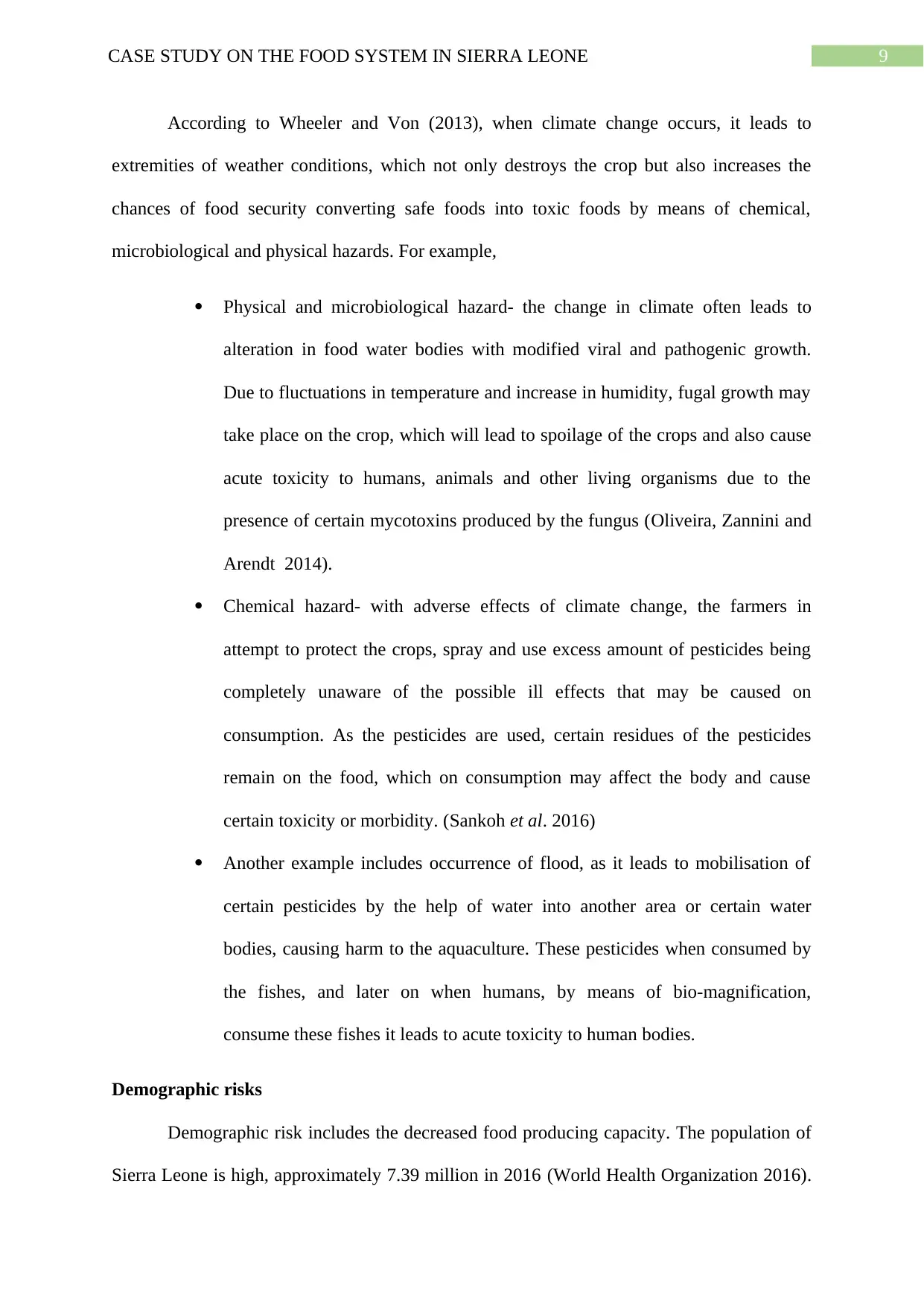
9CASE STUDY ON THE FOOD SYSTEM IN SIERRA LEONE
According to Wheeler and Von (2013), when climate change occurs, it leads to
extremities of weather conditions, which not only destroys the crop but also increases the
chances of food security converting safe foods into toxic foods by means of chemical,
microbiological and physical hazards. For example,
Physical and microbiological hazard- the change in climate often leads to
alteration in food water bodies with modified viral and pathogenic growth.
Due to fluctuations in temperature and increase in humidity, fugal growth may
take place on the crop, which will lead to spoilage of the crops and also cause
acute toxicity to humans, animals and other living organisms due to the
presence of certain mycotoxins produced by the fungus (Oliveira, Zannini and
Arendt 2014).
Chemical hazard- with adverse effects of climate change, the farmers in
attempt to protect the crops, spray and use excess amount of pesticides being
completely unaware of the possible ill effects that may be caused on
consumption. As the pesticides are used, certain residues of the pesticides
remain on the food, which on consumption may affect the body and cause
certain toxicity or morbidity. (Sankoh et al. 2016)
Another example includes occurrence of flood, as it leads to mobilisation of
certain pesticides by the help of water into another area or certain water
bodies, causing harm to the aquaculture. These pesticides when consumed by
the fishes, and later on when humans, by means of bio-magnification,
consume these fishes it leads to acute toxicity to human bodies.
Demographic risks
Demographic risk includes the decreased food producing capacity. The population of
Sierra Leone is high, approximately 7.39 million in 2016 (World Health Organization 2016).
According to Wheeler and Von (2013), when climate change occurs, it leads to
extremities of weather conditions, which not only destroys the crop but also increases the
chances of food security converting safe foods into toxic foods by means of chemical,
microbiological and physical hazards. For example,
Physical and microbiological hazard- the change in climate often leads to
alteration in food water bodies with modified viral and pathogenic growth.
Due to fluctuations in temperature and increase in humidity, fugal growth may
take place on the crop, which will lead to spoilage of the crops and also cause
acute toxicity to humans, animals and other living organisms due to the
presence of certain mycotoxins produced by the fungus (Oliveira, Zannini and
Arendt 2014).
Chemical hazard- with adverse effects of climate change, the farmers in
attempt to protect the crops, spray and use excess amount of pesticides being
completely unaware of the possible ill effects that may be caused on
consumption. As the pesticides are used, certain residues of the pesticides
remain on the food, which on consumption may affect the body and cause
certain toxicity or morbidity. (Sankoh et al. 2016)
Another example includes occurrence of flood, as it leads to mobilisation of
certain pesticides by the help of water into another area or certain water
bodies, causing harm to the aquaculture. These pesticides when consumed by
the fishes, and later on when humans, by means of bio-magnification,
consume these fishes it leads to acute toxicity to human bodies.
Demographic risks
Demographic risk includes the decreased food producing capacity. The population of
Sierra Leone is high, approximately 7.39 million in 2016 (World Health Organization 2016).
Paraphrase This Document
Need a fresh take? Get an instant paraphrase of this document with our AI Paraphraser
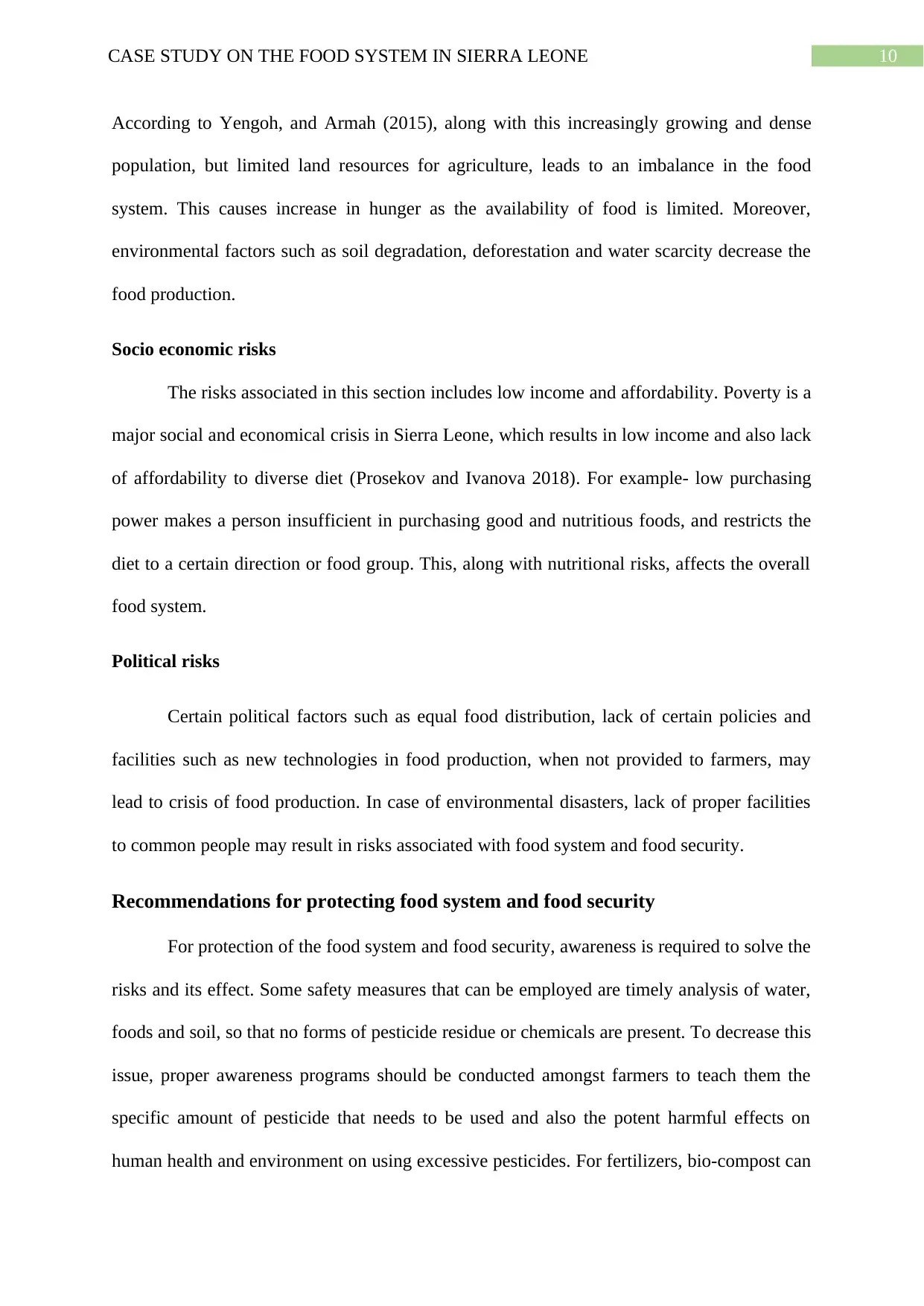
10CASE STUDY ON THE FOOD SYSTEM IN SIERRA LEONE
According to Yengoh, and Armah (2015), along with this increasingly growing and dense
population, but limited land resources for agriculture, leads to an imbalance in the food
system. This causes increase in hunger as the availability of food is limited. Moreover,
environmental factors such as soil degradation, deforestation and water scarcity decrease the
food production.
Socio economic risks
The risks associated in this section includes low income and affordability. Poverty is a
major social and economical crisis in Sierra Leone, which results in low income and also lack
of affordability to diverse diet (Prosekov and Ivanova 2018). For example- low purchasing
power makes a person insufficient in purchasing good and nutritious foods, and restricts the
diet to a certain direction or food group. This, along with nutritional risks, affects the overall
food system.
Political risks
Certain political factors such as equal food distribution, lack of certain policies and
facilities such as new technologies in food production, when not provided to farmers, may
lead to crisis of food production. In case of environmental disasters, lack of proper facilities
to common people may result in risks associated with food system and food security.
Recommendations for protecting food system and food security
For protection of the food system and food security, awareness is required to solve the
risks and its effect. Some safety measures that can be employed are timely analysis of water,
foods and soil, so that no forms of pesticide residue or chemicals are present. To decrease this
issue, proper awareness programs should be conducted amongst farmers to teach them the
specific amount of pesticide that needs to be used and also the potent harmful effects on
human health and environment on using excessive pesticides. For fertilizers, bio-compost can
According to Yengoh, and Armah (2015), along with this increasingly growing and dense
population, but limited land resources for agriculture, leads to an imbalance in the food
system. This causes increase in hunger as the availability of food is limited. Moreover,
environmental factors such as soil degradation, deforestation and water scarcity decrease the
food production.
Socio economic risks
The risks associated in this section includes low income and affordability. Poverty is a
major social and economical crisis in Sierra Leone, which results in low income and also lack
of affordability to diverse diet (Prosekov and Ivanova 2018). For example- low purchasing
power makes a person insufficient in purchasing good and nutritious foods, and restricts the
diet to a certain direction or food group. This, along with nutritional risks, affects the overall
food system.
Political risks
Certain political factors such as equal food distribution, lack of certain policies and
facilities such as new technologies in food production, when not provided to farmers, may
lead to crisis of food production. In case of environmental disasters, lack of proper facilities
to common people may result in risks associated with food system and food security.
Recommendations for protecting food system and food security
For protection of the food system and food security, awareness is required to solve the
risks and its effect. Some safety measures that can be employed are timely analysis of water,
foods and soil, so that no forms of pesticide residue or chemicals are present. To decrease this
issue, proper awareness programs should be conducted amongst farmers to teach them the
specific amount of pesticide that needs to be used and also the potent harmful effects on
human health and environment on using excessive pesticides. For fertilizers, bio-compost can
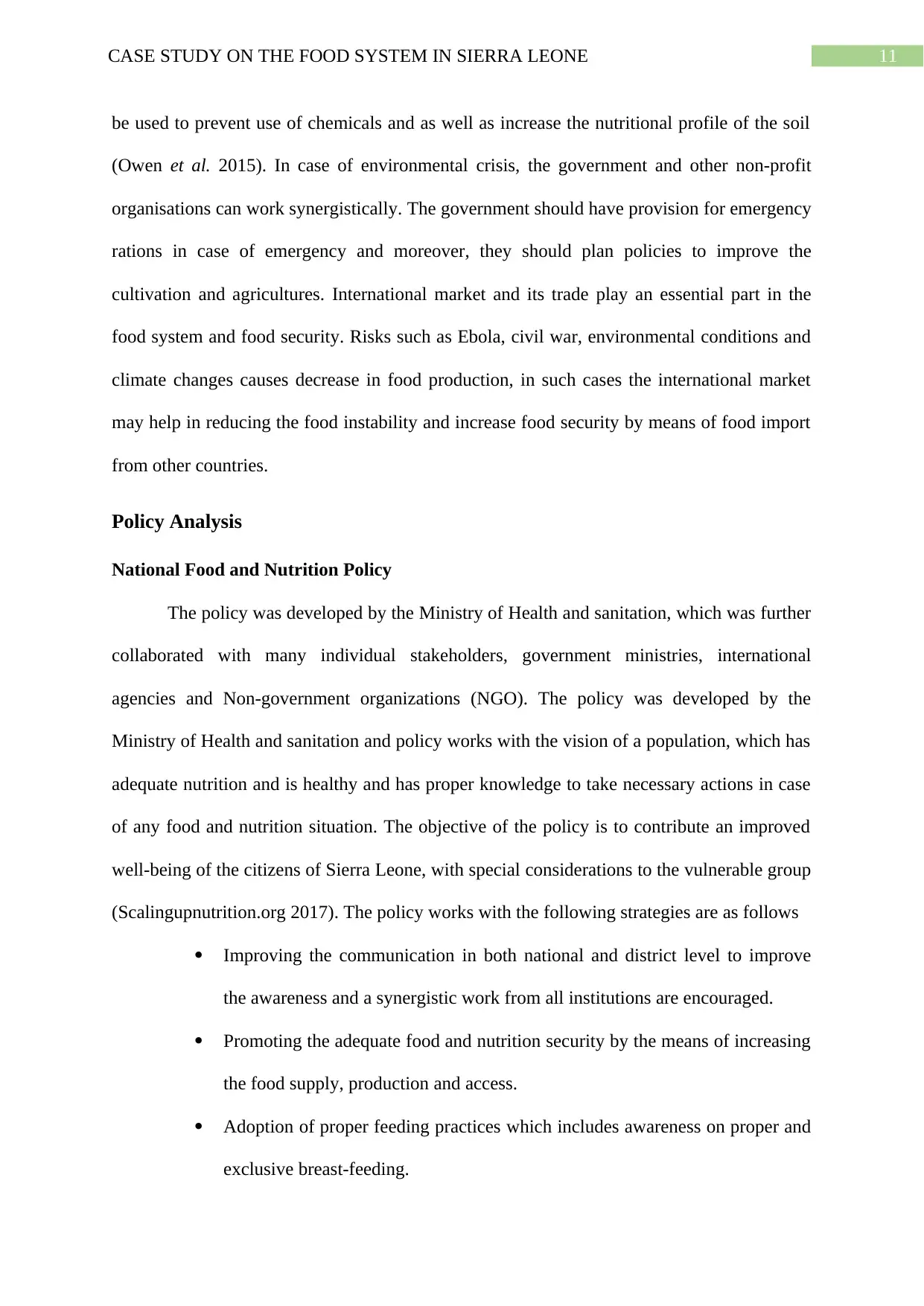
11CASE STUDY ON THE FOOD SYSTEM IN SIERRA LEONE
be used to prevent use of chemicals and as well as increase the nutritional profile of the soil
(Owen et al. 2015). In case of environmental crisis, the government and other non-profit
organisations can work synergistically. The government should have provision for emergency
rations in case of emergency and moreover, they should plan policies to improve the
cultivation and agricultures. International market and its trade play an essential part in the
food system and food security. Risks such as Ebola, civil war, environmental conditions and
climate changes causes decrease in food production, in such cases the international market
may help in reducing the food instability and increase food security by means of food import
from other countries.
Policy Analysis
National Food and Nutrition Policy
The policy was developed by the Ministry of Health and sanitation, which was further
collaborated with many individual stakeholders, government ministries, international
agencies and Non-government organizations (NGO). The policy was developed by the
Ministry of Health and sanitation and policy works with the vision of a population, which has
adequate nutrition and is healthy and has proper knowledge to take necessary actions in case
of any food and nutrition situation. The objective of the policy is to contribute an improved
well-being of the citizens of Sierra Leone, with special considerations to the vulnerable group
(Scalingupnutrition.org 2017). The policy works with the following strategies are as follows
Improving the communication in both national and district level to improve
the awareness and a synergistic work from all institutions are encouraged.
Promoting the adequate food and nutrition security by the means of increasing
the food supply, production and access.
Adoption of proper feeding practices which includes awareness on proper and
exclusive breast-feeding.
be used to prevent use of chemicals and as well as increase the nutritional profile of the soil
(Owen et al. 2015). In case of environmental crisis, the government and other non-profit
organisations can work synergistically. The government should have provision for emergency
rations in case of emergency and moreover, they should plan policies to improve the
cultivation and agricultures. International market and its trade play an essential part in the
food system and food security. Risks such as Ebola, civil war, environmental conditions and
climate changes causes decrease in food production, in such cases the international market
may help in reducing the food instability and increase food security by means of food import
from other countries.
Policy Analysis
National Food and Nutrition Policy
The policy was developed by the Ministry of Health and sanitation, which was further
collaborated with many individual stakeholders, government ministries, international
agencies and Non-government organizations (NGO). The policy was developed by the
Ministry of Health and sanitation and policy works with the vision of a population, which has
adequate nutrition and is healthy and has proper knowledge to take necessary actions in case
of any food and nutrition situation. The objective of the policy is to contribute an improved
well-being of the citizens of Sierra Leone, with special considerations to the vulnerable group
(Scalingupnutrition.org 2017). The policy works with the following strategies are as follows
Improving the communication in both national and district level to improve
the awareness and a synergistic work from all institutions are encouraged.
Promoting the adequate food and nutrition security by the means of increasing
the food supply, production and access.
Adoption of proper feeding practices which includes awareness on proper and
exclusive breast-feeding.
⊘ This is a preview!⊘
Do you want full access?
Subscribe today to unlock all pages.

Trusted by 1+ million students worldwide
1 out of 17
Related Documents
Your All-in-One AI-Powered Toolkit for Academic Success.
+13062052269
info@desklib.com
Available 24*7 on WhatsApp / Email
![[object Object]](/_next/static/media/star-bottom.7253800d.svg)
Unlock your academic potential
Copyright © 2020–2025 A2Z Services. All Rights Reserved. Developed and managed by ZUCOL.




